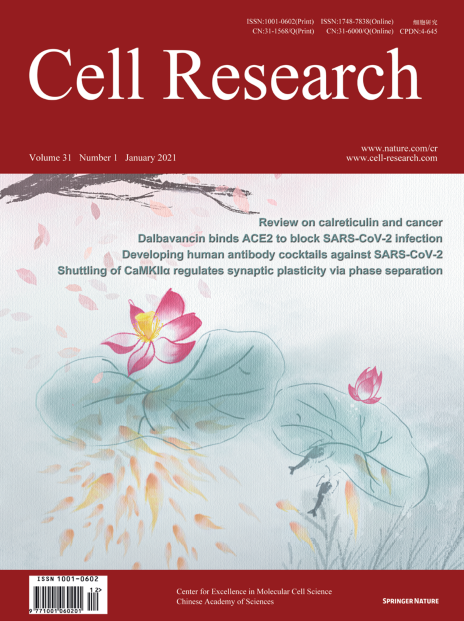
Advanced Search
Submit Manuscript
Advanced Search
Submit Manuscript
Volume 31, No 1, Jan 2021
ISSN: 1001-0602
EISSN: 1748-7838 2018
impact factor 17.848*
(Clarivate Analytics, 2019)
Volume 31 Issue 1, January 2021: 17-24 |
Dalbavancin binds ACE2 to block its interaction with SARS-CoV-2 spike protein and is effective in inhibiting SARS-CoV-2 infection in animal models
Gan Wang1 , Meng-Li Yang2 , Zi-Lei Duan1 , Feng-Liang Liu1 , Lin Jin1 , Cheng-Bo Long1 , Min Zhang1,3 , Xiao-Peng Tang1,4 , Ling Xu1 , Ying-Chang Li1 , Peter Muiruri Kamau1,3,4 , Lian Yang5 , Hong-Qi Liu2 , Jing-Wen Xu2 , Jie-Kai Chen6 , Yong-Tang Zheng1,7,* , Xiao-Zhong Peng2,* , Ren Lai1,4,7,8,*
1Key Laboratory of Animal Models and Human Disease Mechanisms, Chinese Academy of Sciences/Key Laboratory of Bioactive Peptides of Yunnan Province, KIZ-CUHK Joint Laboratory of Bioresources and Molecular Research in Common Diseases, National Resource Center for Non-Human Primates, Kunming Primate Research Center, and National Research Facility for Phenotypic & Genetic Analysis of Model Animals (Primate Facility), Kunming Institute of Zoology, Kunming, Yunnan 650107, ChinaInfection with severe acute respiratory syndrome coronavirus 2 (SARS-CoV-2) has caused a pandemic worldwide. Currently, however, no effective drug or vaccine is available to treat or prevent the resulting coronavirus disease 2019 (COVID-19). Here, we report our discovery of a promising anti-COVID-19 drug candidate, the lipoglycopeptide antibiotic dalbavancin, based on virtual screening of the FDA-approved peptide drug library combined with in vitro and in vivo functional antiviral assays. Our results showed that dalbavancin directly binds to human angiotensin-converting enzyme 2 (ACE2) with high affinity, thereby blocking its interaction with the SARS-CoV-2 spike protein. Furthermore, dalbavancin effectively prevents SARS-CoV-2 replication in Vero E6 cells with an EC50 of ~12 nM. In both mouse and rhesus macaque models, viral replication and histopathological injuries caused by SARS-CoV-2 infection are significantly inhibited by dalbavancin administration. Given its high safety and long plasma half-life (8–10 days) shown in previous clinical trials, our data indicate that dalbavancin is a promising anti-COVID-19 drug candidate.
https://doi.org/10.1038/s41422-020-00450-0